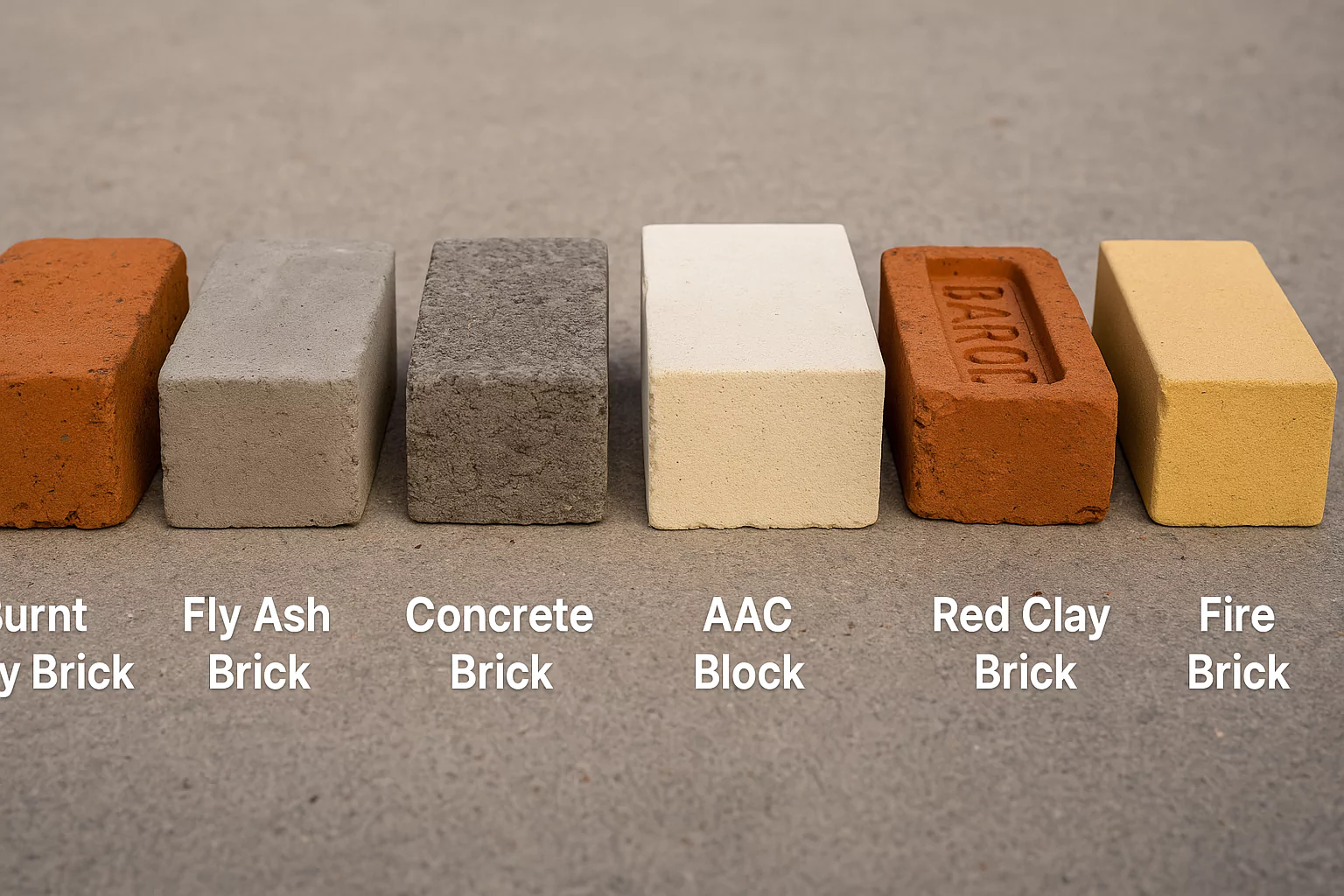Bricks have served as one of humanity’s earliest and most enduring building materials. From the ancient sun-dried mud bricks of the Indus Valley Civilization to the high-tech AAC blocks used in today’s high-rises, the evolution of bricks reflects the progress of architecture and engineering over centuries. In India, bricks have transitioned from purely manual, labor-intensive processes to sophisticated, eco-conscious production methods that meet the demands of modern construction. For today’s home buyers, understanding these options is essential to ensure long-term quality, cost-efficiency, and structural integrity.
Bricks can be classified in various ways:
- Based on Manufacturing Method:
- Burnt Bricks: Made by burning in kilns. Durable and commonly used.
- Unburnt Bricks: Sun-dried. Suitable for temporary structures.
- Based on Material:
- Clay, Fly Ash, Concrete, AAC, etc.
- Based on Purpose:
- Load-bearing vs. Non-load-bearing
Types of Bricks Used in India
1. Burnt Clay Bricks
Burnt clay bricks are among the oldest and most traditional building materials used in India. Originating from ancient techniques of molding clay and firing it in kilns, these bricks became standard during colonial times when uniformity in construction gained importance. Over time, burnt clay bricks were categorized into four classes based on quality, with Class 1 being premium grade.
- Grades: Class 1 (best quality) to Class 4 (lowest)
- Usage: Foundations, walls
- Pros: Durable, good strength, widely available
- Cons: Not energy-efficient, uneven sizes
2. Fly Ash Bricks
Fly ash bricks emerged in the late 20th century as a sustainable alternative, utilizing the fine powder residue from coal combustion in thermal power plants. Their invention was driven by the need to repurpose industrial waste and reduce the carbon footprint of traditional brick kilns. Over the years, these bricks gained popularity in urban India, particularly for high-rise buildings.
- Standard: IS 12894
- Usage: High-rise buildings, internal walls
- Pros: Smooth finish, lightweight, less water absorption
- Cons: Needs careful curing, brittle if not manufactured properly
3. Concrete Bricks
Concrete bricks are a relatively modern innovation, developed in response to the need for uniformity, fast production, and aesthetics in urban construction. These bricks began gaining traction in the mid-20th century as cement became more widely available. Their molded, machine-made nature made them ideal for boundary walls and facades.
- Usage: Facades, fences, internal walls
- Pros: Fire-resistant, good aesthetic appeal
- Cons: Heavier than clay bricks, not ideal for load-bearing walls
4. AAC Blocks (Autoclaved Aerated Concrete)
AAC blocks were developed in Sweden in the early 20th century but only gained significant popularity in India in the last two decades. As the construction industry focused more on energy efficiency and earthquake resistance, these lightweight, aerated blocks became a top choice for large residential and commercial projects.
- Usage: Apartments, high-rise buildings
- Pros: Thermal insulation, earthquake-resistant, faster construction
- Cons: Higher cost, requires skilled labor
5. Red Clay Bricks
Red clay bricks have been the backbone of Indian construction for centuries. Originally made using manual molds and sun drying, they evolved through the introduction of brick kilns and mechanized production. Despite the rise of modern alternatives, red bricks remain popular in rural and semi-urban areas for their familiarity and accessibility.
- Usage: General purpose construction
- Pros: Strong, readily available
- Cons: Irregular shapes, high water absorption
6. Fire Bricks (Refractory Bricks)
Fire bricks were developed specifically for industrial applications that involve extreme heat. Their use in Indian construction began with the expansion of industries like steel, ceramics, and glass. Made using special clay and minerals, these bricks are designed to retain strength and shape at high temperatures.
- Usage: Fireplaces, chimneys, industrial furnaces
- Pros: Heat-resistant
- Cons: Expensive, used for specific needs only
7. Engineering Bricks
Engineering bricks are high-performance bricks with superior compressive strength and water resistance. Though widely used in the UK and Europe, they are selectively used in India—mostly in infrastructure projects like bridges and underground tunnels. Their low porosity and resilience make them suitable for challenging environments.
- Usage: Foundations, basements
- Pros: Water-resistant, strong
- Cons: Costly, not commonly used in residential projects in India
Comparison Table
| Brick Type | Strength | Weight | Cost | Insulation | Use Case |
|---|---|---|---|---|---|
| Clay Bricks | High | Medium | Low | Low | General |
| Fly Ash Bricks | Medium | Light | Medium | High | Urban Homes |
| AAC Blocks | Medium | Light | High | Very High | High-Rise |
| Concrete Bricks | Medium | Heavy | Medium | Medium | Facades/Fences |
How to Choose the Right Brick for Your Home
When deciding on the type of brick, consider:
- Climate: AAC blocks are great for hot climates due to insulation.
- Location: Remote areas may not have access to modern bricks.
- Structure Type: Load-bearing vs. frame structure
- Budget: Balance between cost and long-term benefits
Conclusion
Choosing the right brick is more than just a construction detail; it’s an investment in your home’s strength and longevity. Whether you opt for traditional clay bricks or modern AAC blocks, ensure you consult your architect or structural engineer before making the final decision. For home buyers, this knowledge can empower better conversations with builders and contractors.



